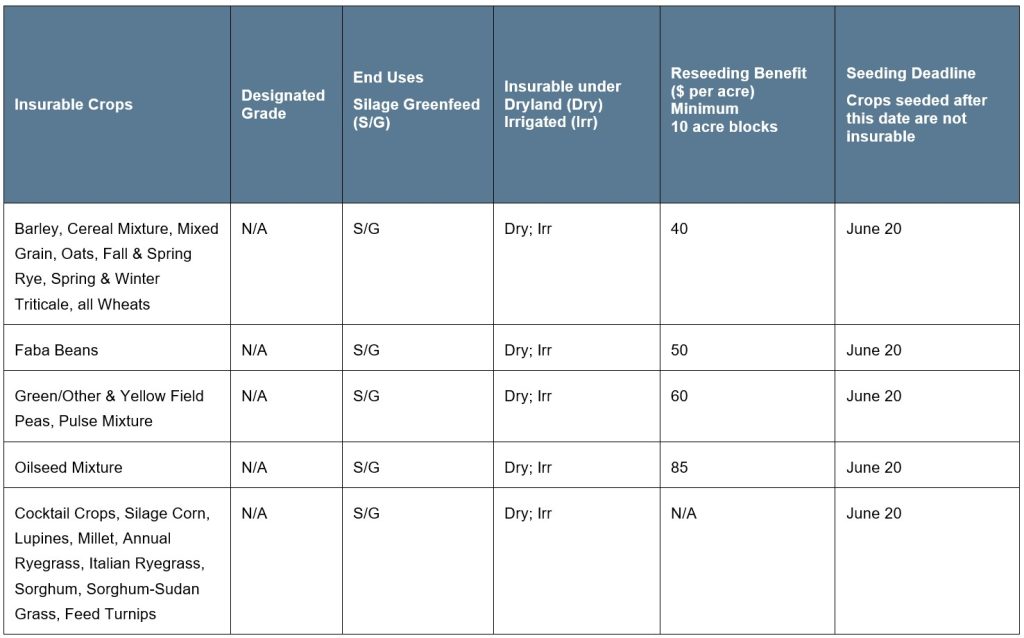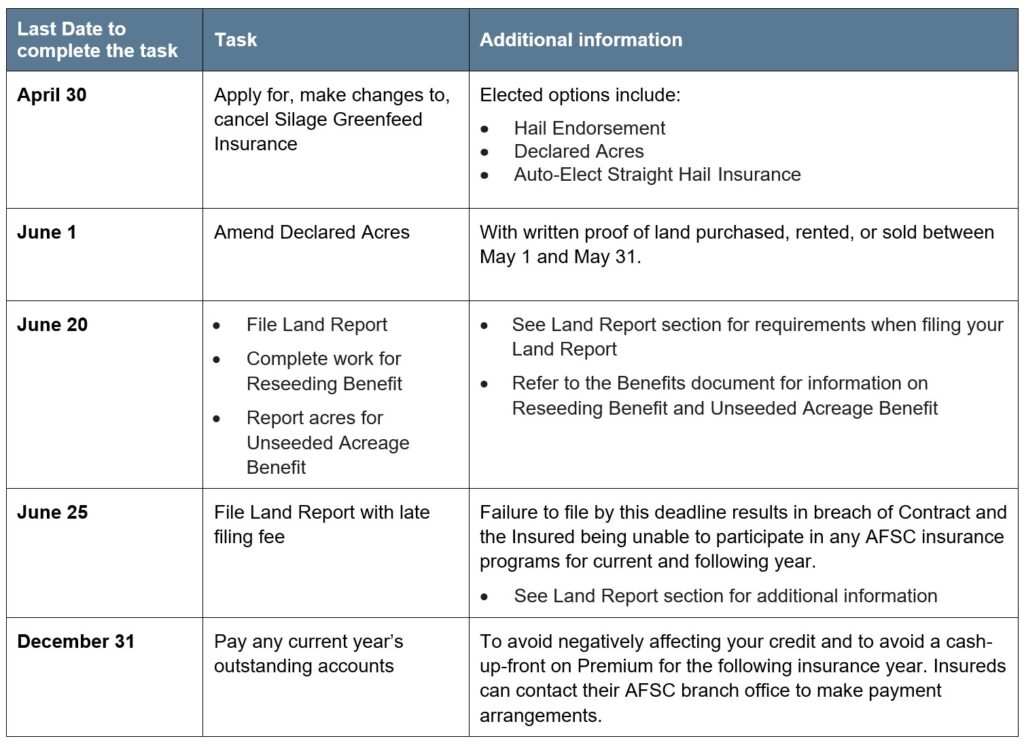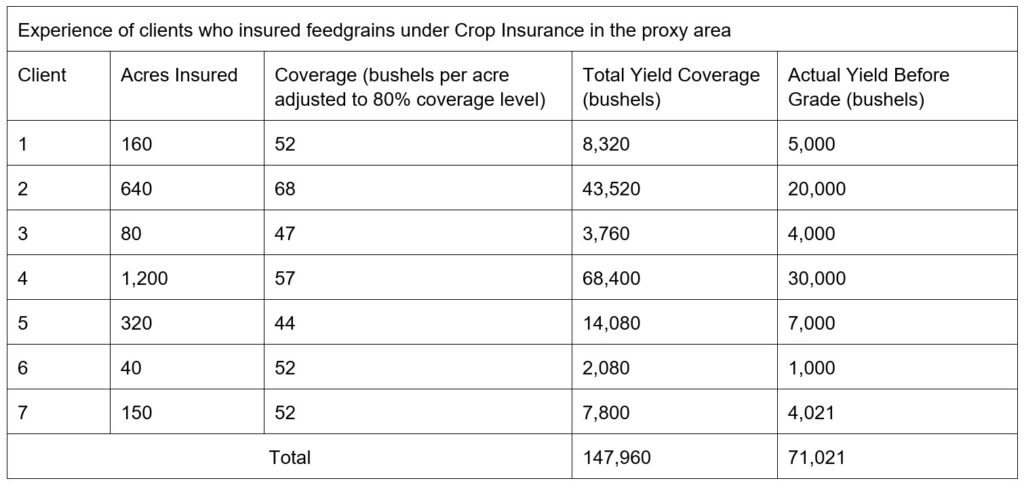Silage Greenfeed Insuring Agreement – Barley Proxy 2025
Silage Greenfeed Insuring Agreement - Barley Proxy
AFSC will indemnify the Insured against damage caused by Designated Perils to the Insured Feedgrains in the Proxy Area for the Insured’s Silage Greenfeed crops pursuant to this Insuring Agreement. This Insuring Agreement incorporates by reference, and is subject to, the Terms and Conditions and Benefits. The definitions in the Terms and Conditions will apply unless the same term is otherwise defined in this Insuring Agreement.
Silage Greenfeed Insurance is an area-based program that provides an alternative for silage crops and does not require pre-harvest or post harvest inspections. Since individual production does not trigger the loss, the list of crops that can be insured as silage under an area-based approach can be expanded from those eligible under a production-based program.
“Insurable Crop” means the following crops intended for Silage, Greenfeed or swath grazing: Barley, Cocktail Crops, Corn (Silage), Faba Beans, Green/Other Field Peas, Yellow Field Peas, Lupines, Millet, Cereal Mixture, Oilseed Mixture, Pulse Mixture, Mixed Grain, Oats, Fall Rye, Spring Rye, Annual Ryegrass, Italian Ryegrass, Sorghum, Sorghum-Sudan Grass, Spring Triticale, Winter Triticale, Feed Turnips, Canada Northern Hard Red Wheat, Canada Prairie Spring Wheat, Canada Western Special Purpose Wheat, Durum Wheat, Extra Strong Red Spring Wheat, Hard Red Spring Wheat, Hard Red Winter Wheat, or Soft White Spring Wheat.
“Cocktail Crops” means an Insurable Crop that:
a. is comprised of a minimum of three different crop types;
b. the Primary Crop is an Insurable Crop under this Insuring Agreement, excluding Cereal Mixture, Oilseed Mixture or Pulse Mixture; and
c. the Primary Crop is the largest crop in population of the plant stand and comprises a minimum of 35 percent or more of the established plant stand.
“Designated Peril” The Designated Perils listed under Article 1 of the Terms and Conditions do not apply to this Insuring Agreement. Rather it is based on the Adjusted Production, excluding grade loss, of the Insured Feedgrains in the Proxy Area.
“Dollar Coverage per Acre” means 80 percent of the Risk Area Normal for barley multiplied by the township coverage adjustment for silage greenfeed multiplied by the Spring Insurance Price.
“Insured Feedgrains” means the following crops used to determine Proxy Area Adjusted Production: barley, mixed grain, oats, spring rye and spring triticale.
“Payment Rate” means the rate of compensation at which the Insured is indemnified, as determined by AFSC.
“Primary Crop” means the largest single crop type or variety in a stand of multiple crop types or varieties.
“Proxy Area” means the township where the Insured Crop is located if there are six or more clients with Insured Feedgrains in the Cereal and Oilseed Crops Insuring Agreement and/or the Pedigreed Crops Insuring Agreement in that township, otherwise the size of the Proxy Area will be increased by adding all adjacent townships until there are a minimum of six Insured Feedgrain clients.
“Proxy Area Adjusted Production” means the same as Adjusted Production in the Terms and Conditions but excludes grade relative to Designated Grade and is represented by the sum of production in the Proxy Area for Insured Feedgrains in the Cereal and Oilseeds Insuring Agreement and/or the Pedigreed Crops Insuring Agreement, separately for dryland and irrigated land.
“Proxy Area Coverage” means the Coverage for the Proxy Area based on the sum of each Insured Feedgrains Final Individual Normal Yield for the Insured, calculated at the 80 percent Coverage Level, multiplied by their respective insured acres in the Cereal and Oilseed Insuring Agreement and/or the Pedigreed Crops Insuring Agreement, separately for dryland and irrigated land.
a. In the case of Corn (Silage), the Dollar Coverage per Acre is increased by $85.
a. Insurable Crop(s) grown on irrigated land are eligible for separate Coverage if:
i. those crops are declared as irrigated;
ii. there is an adequate source of water;
iii. the Insured has reliable irrigation equipment;
iv. adequate irrigation water is applied on a timely basis; and
v. the Insured maintains an up-to-date log showing the dates and approximate amounts of rainfall and irrigation water applied to each Insured Crop.
b. AFSC may reclassify the Insured Crop as grown on Stubble or Summerfallow on dryland if:
i. the Insured fails to fulfill all or part of the conditions in subsection a. above; or
ii. drought is considered by AFSC to be a contributing cause of loss.
c. Irrigated acres are insured separately from dryland acres of the same crop:
i. acres must be identified as irrigated or dryland on the Land Report.
a. Spring Insurance Price: In the spring, AFSC forecasts expected crop prices for the coming Crop Year, and for this Insuring Agreement, it is equal to the Spring Insurance Price for Barley (1 CW).
b. Fall Market Price: In the fall, AFSC reviews the pricing using specific methodologies, as described in the table below, to determine whether the crop’s Fall Market Price is substantially lower or higher than the Spring Insurance Price and sets Fall Prices accordingly.
c. Variable Price Benefit: is offered to protect against price fluctuations between the Spring Insurance Price and the Fall Price. Refer to the Benefits document for information.
The Variable Price Benefit triggers when the Fall Price of an eligible crop increases by a minimum of 10% above the Spring Insurance Price, and compensates when the Policy has received an Indemnity.
Market Price Methodology Table
In the event that price information originating from published Fall Market Price methodology for an Insurable Crop(s) is not available or stops being available during the Fall Market Price period, at its best discretion, AFSC maintains the right to develop and implement an alternate price methodology for Fall Market Price determination to replace or augment pricing for that crop(s) in that year.
a. Minimum Premium: There is a minimum $25 of total Premium required per insurance Policy.
b. Rates: Premium rates are set annually and reflect AFSC’s risk of future losses. For the Barley Proxy option, premium rates are based on the Risk Area’s production losses of Insured Feedgrains under Crop Insurance. The Insured’s Premium is calculated by multiplying the Dollar Coverage per Acre by the Insured’s share of the premium rate and applying any applicable discounts.
c. Cost Share: Federal and provincial governments support AgriInsurance programs by paying all administration expenses and sharing premium costs with the Insured.
d. Adjustments & Discounts:
a. Application: New clients must apply for insurance on or before April 30 and AFSC will evaluate eligibility for insurance. Producers are required to demonstrate their legal, financial and operational independence, and can contact AFSC for application documents.
b. Renewal Process: Insurance remains in effect from year to year therefore an Insured who elected Silage Greenfeed Insurance in the previous year will be automatically renewed based upon the previous year’s information. Personalized renewal notices are available in March. The Insured is responsible to review the information and if changes are required, complete a change request form online or return the form to an AFSC insurance representative by mail, fax, email, in person, or request changes by phone, by April 30.
c. Declared Acres: are the total number of acres seeded and those intended to be seeded to Silage and Greenfeed Crops, including crops intended to be combined, whether the acres are to be insured or uninsured.
d. Hail Endorsement: offers spot-loss coverage and may be elected with Silage Greenfeed Insurance by April 30.
Refer to the Hail Endorsement Insuring Agreement for additional information.
e. Auto-Elect Straight Hail Insurance: may be elected with Silage Greenfeed Insurance by April 30. When elected, a two percent premium discount will be applied on the Straight Hail Statement of Coverage and Premium.
Straight Hail Insurance can be purchased on a field-by-field basis until July 31. Refer to the Straight Hail Contract of Insurance for additional information.
a. If an Insured Crop intended for Silage or Greenfeed is pastured, then the insurance Coverage and Premium will remain in effect.
a. The Unharvested Acreage Benefit is not available under this Insuring Agreement.
If a reporting deadline date falls on a weekend, the deadline will be extended to the next Business Day.
Other Important Deadlines
a. All eligible and seeded acreage of an Insurable Crop (dryland and irrigated), whether the land is owned, rented or crop-shared, grown for the intent of Silage or Greenfeed must be insured. Acres insured under this Insuring Agreement are not insurable under any other crop insurance program, except for applicable Endorsements, or where AFSC has consented in writing.
Cash rent and crop-share landlords are not eligible for insurance as they are not responsible for the agronomic decisions and do not receive the majority of the proceeds from the sale of the crop.
b. If the Insured intends to combine some of the acres for grain, and manage the remaining acres as Silage, Greenfeed, or swath grazing, they can insure acres of the same Insurable Crop under both Crop Insurance and Silage Greenfeed Insurance.
c. If AFSC determines acres of an Insured Crop and the crop type and/or acres differ from those reported by the Insured, the following will apply:
i. When completing reseed inspections or unseeded inspections or acreage verifications, AFSC will issue a revised Statement of Coverage and Premium based on the crop type and actual number of seeded acres calculated by AFSC and any Indemnity calculation shall be based on the crop type and actual acres determined.
d. AFSC is not required or in any way obligated to revise or adjust its calculation of insured acres for any preceding year.
a. A Land Report must be filed once seeding is finished and no later than June 20.
b. The Insured must report all annual spring and fall crops on land that is owned, rented, or crop-shared and include the following information for each field:
i. legal land description for the location including the part;
ii. number of seeded acres or the number of acres intended for Summerfallow in the current year;
iii. whether the field is to be insured or uninsured;
iv. type of crop seeded;
v. insured end use (e.g. silage greenfeed);
vi. whether the acres are seeded on Stubble or Summerfallow; and on dryland or irrigated land;
vii. seeding date;
viii. cropping and tillage practice;
ix. report acres too wet to seed by quarter section, including whether fertilizer had been incorporated or not, and if the land is irrigated or not; and
x. summary of insured acres for each crop.
c. Failure to file a Land Report will result in all insurance Policies being cancelled and restrictions on future year’s program participation. Where the Insured fails to file a Land Report by the June 20 deadline AFSC may, in its discretion:
i. accept the Land Report, if received by June 25, and assess a late filing fee to be paid by the Insured in full before the start of the next Crop Year;
ii. if due to extenuating circumstances, AFSC has the discretion to determine the acreage seeded by the Insured and file a Land Report for the Insured which shall be binding on the Insured; or
iii. cancel this Contract or any part thereof for the current Crop Year, in which case the Insured will be unable to participate in any AFSC insurance programs for current and following year with the following exceptions:
1) Livestock Price Insurance can be purchased in the current year; and
2) Straight Hail Insurance can be purchased in the following year.
d. AFSC reserves the right to reject requests for changes to the Land Report after the June 20 filing deadline.
a. Information provided by the Insured is used to generate a Statement of Coverage and Premium, which explains Coverage and Premium and states AFSC’s coverage limit.
b. The Insured should review their Statement of Coverage and Premium carefully to ensure it is complete and accurate. Errors and omissions must be reported to AFSC within 15 calendar days of receipt.
c. AFSC reserves the right to deny additional Coverage when information contained on the Statement of Coverage and Premium reflects what is reported on the Land Report.
a. The Insured is not required to submit a Notice of Loss to initiate a claim for damage caused by Designated Perils to the Insured Feedgrains in the Proxy Area.
b. For the following claims, the Insured is required to submit a Notice of Loss and the deadline to initiate a claim are as follows:
i. Reseeding Benefit: contact AFSC prior to taking acres intended for reseeding out of production. Refer to Benefits document for information.
ii. Unseeded Acreage Benefit: via the Land Report on or before June 20.
c. If the Insured is late in filing a Notice of Loss AFSC may reject the claim.
a. Upon receipt of a claim for loss:
i. where AFSC processes a claim, AFSC will serve the Insured with a Statement of Loss.
ii. where AFSC’s process is to conduct an inspection, following the inspection, AFSC will serve the Insured with a copy of the Inspection Report.
b. If the calculation of a claim for loss results in no payment, the Statement of Loss will be considered the final Statement of Loss for the claim by the
Insured and no further Statement of Loss will be issued by AFSC.
c. If the Inspection Report results in no payment, or if as a result of the Inspection Report the claim for loss is withdrawn by the Insured, the Inspection Report will be considered to be the final Statement of Loss for the claim by the Insured and no further Statement of Loss will be issued by AFSC.
d. If the Insured does not, within seven days of service of the Inspection Report, advise AFSC of the Insured’s disagreement with the report or does not request a re-inspection, AFSC will issue the Statement of Loss according to the Inspection Report.
a. After an inspection, pursuant to Section 8.02 (c) if the Insured, within seven days of service of the Inspection Report:
i. advises AFSC of the Insured’s disagreement with the report; and
ii. requests a re-inspection:
AFSC will conduct a re-inspection, and no Statement of Loss will be issued until after the re-inspection has been conducted. AFSC reserves the right to charge a fee for Insured requested re-inspection of crops, or re-grading of samples.
a. The procedures set out in AFSC’s adjusting procedure manuals shall be used in the assessment of an insurable loss of an Insured Crop.
AFSC recommends the Insured or Authorized Representative accompany adjusters during on-farm inspections.
a. Service of the Statement of Loss may be effected on the Insured by:
i. personal service;
ii. ordinary mail or registered mail, in which case service is deemed to have been effected;
1) seven days from the date of mailing if the document is mailed in Alberta to an address in Alberta, or
2) 14 days from the date of mailing if the document is mailed to an address located outside of Alberta; or
iii. by facsimile, email or other electronic means in accordance with AFSC’s most recent records for the Insured.
b. Where there is more than one Insured in respect of the crop loss, service of the Statement of Loss on one of the Insured is deemed to be service on all the Insureds.
a. To facilitate tax planning, Insureds can choose in advance to defer Indemnities to the following tax year. There will be no recourse to defer payment once a payment has been issued. Deferred Indemnities will not be applied to outstanding Premiums/balances until the deferred date and interest will continue to accrue.
a. Stage 1 on or Before June 20 (Refer to the Benefits document)
b. Stage 2 on or After June 21
i. An Indemnity shall be calculated separately for dryland and irrigated land as follows:
[Dollar Coverage per Acre x Insured Acres x Payment Rate]
The maximum Indemnity payable shall be 100% of the Dollar Coverage.
ii. Compensation for barley proxy losses is based on the Payment Rate of the Insured Feedgrains under Crop Insurance in the immediate Proxy Area. Payment Rate for the Proxy Area is based on:
1) the total production coverage at the 80 percent level for all Insured Feedgrains in the Proxy Area
2) the total production, excluding grade adjustments, for all Insured Feedgrains in the Proxy Area
iii. The Payment Rate for a Proxy Area is the difference between the Proxy Area Adjusted Production and Proxy Area Coverage compared to Proxy Area Coverage, expressed as a percentage. When the Proxy Area Adjusted Production is less then Proxy Area Coverage, and will be calculated as follows:
((Proxy Area Coverage) – (Proxy Area Adjusted Production)) / (Proxy Area Coverage) x 100%
iv. If Proxy Area Adjusted Production is not available or insufficient to calculate the Payment Rate, this Contract will cease to be enforceable against AFSC and cease to have any effect against AFSC. AFSC will then return to the Insured all paid Premium, less any applicable discount.
c. In no case, for an Insured Crop, shall the combined Indemnities under any Insuring Agreement (including Hail Endorsement) exceed total dollar coverage (Dollar Coverage per Acre x Insured Acres) under this Contract.
Indemnity: Calculation Example for Barley Proxy
Assumption: Insured’s coverage is $150 per acre on 200 acres of silage = $30,000 total coverage
a. Township claim rate for Insured Feedgrains at 80% coverage
= [(Total yield coverage less actual yield before grade) divided by total yield coverage] times 100 percent
= [(147,960 – 71,021) / 147,960] x 100%
= 52%
b. Claim Calculation
= Total dollar coverage times township claim rate for Insured Feedgrains at 80% Coverage
= $30,000 x 52%
= $15,600







